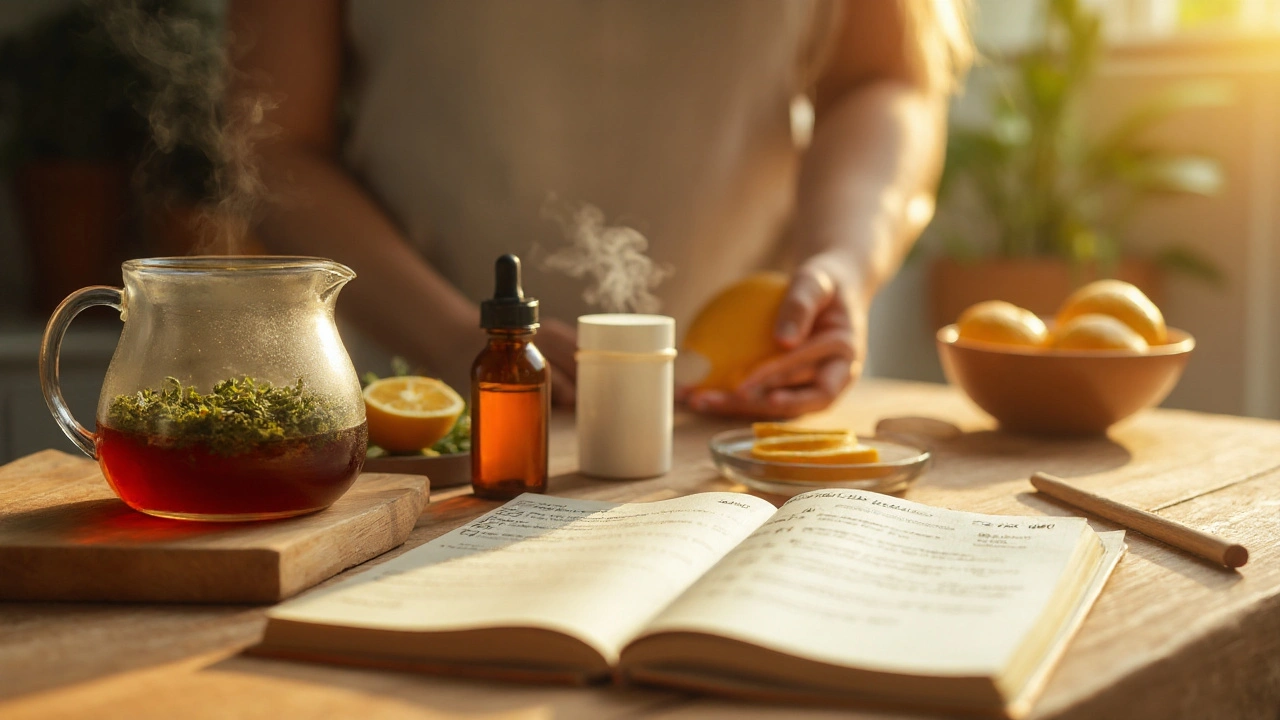Looking for a single supplement to cover a lot of bases-immune support, calm inflammation, easier throat days, steadier energy-without falling for hype? Rabdosia rubescens (also called Donglingcao) gets a lot of buzz for “total body wellness.” It’s intriguing, but not magic. The research is promising for a handful of uses, thin for others, and safety means paying attention to interactions. Here’s the straight story, plus a simple plan so you can decide if it belongs in your routine or back on the shelf.
TL;DR: What Rabdosia Rubescens Can and Can’t Do
- Quick take: Traditionally used in Chinese medicine for throat and inflammatory complaints, Rabdosia rubescens shows anti‑inflammatory and immune‑modulating effects in lab and early human studies. It’s not a cure‑all.
- Where it may help: Sore or scratchy throat days, general inflammatory tone, and as a supportive herb in a broader wellness stack. Evidence is early but encouraging for throat comfort and biomarkers of inflammation.
- Where evidence is weak: Direct “disease treatment” claims (cancer, infections, autoimmune diseases). Most data there are preclinical or small studies. Don’t use it in place of medical care.
- Safety snapshot: Usually well tolerated at labeled doses. Possible GI upset, lightheadedness, and lower blood pressure. Avoid with blood thinners/antiplatelets, before surgery, during pregnancy/breastfeeding, or if you have bleeding disorders. Talk to your clinician if you take prescription meds.
- How to start: Choose a third‑party tested extract, begin low (e.g., half dose with food), track how you feel for 2-4 weeks, and reassess. If nothing changes by week four, consider stopping.
What It Is, How It Works, and What the Research Actually Shows
Rabdosia rubescens (also listed as Isodon rubescens or Donglingcao) is a mint family plant used in traditional Chinese medicine (TCM) mostly for pharyngeal and inflammatory complaints. Its best‑known constituents are ent‑kaurane diterpenoids like oridonin and ponicidin. In test tubes and animals, these compounds dampen inflammatory pathways (NF‑κB, NLRP3), influence apoptosis in abnormal cells, and modulate immune responses. That sounds great-but lab effects don’t always translate 1:1 in people.
What do we know in humans as of 2025?
- Throat discomfort and chronic pharyngitis: Chinese Pharmacopoeia includes Donglingcao preparations for sore throat. Several small, methodologically mixed trials report symptom relief versus comparators over 1-2 weeks. These are often combination formulas, which muddies attribution.
- Inflammation: Pilot studies have tracked shifts in markers like CRP and IL‑6 with Donglingcao‑containing regimens. Results lean positive but are not definitive because of small samples and co‑interventions.
- Immune balance: Early human data suggest gentle immune modulation (not immune “stimulation” in the energy drink sense). This may be one reason some users notice fewer “scratchy throat” mornings during seasonal swings.
- Digestive comfort: Anecdotal use is common, but rigorous trials are sparse. A few small studies suggest calmer reflux‑like symptoms when used with diet changes, but evidence is not strong enough to stand alone.
- Cancer adjunct research: Preclinical work on oridonin is active, and some small clinical experiences exist in China. Major cancer centers (e.g., Memorial Sloan Kettering’s Integrative Medicine service) discuss it as investigational. There’s no high‑quality evidence it treats cancer by itself. If you’re in oncology care, any herb must be cleared by your team.
Authoritative sources: The Chinese Pharmacopoeia documents Donglingcao’s traditional indications and dosing ranges. Memorial Sloan Kettering’s About Herbs database summarizes mechanisms, potential interactions (notably antiplatelet effects), and the state of clinical evidence. Reviews in journals like Journal of Ethnopharmacology and Phytomedicine cover oridonin’s mechanisms and preclinical data. The U.S. NIH’s NCCIH reminds us that supplements sold in America are not pre‑approved for efficacy; quality varies widely.
The bottom line from the research: credible mechanisms, traditional use that aligns with modern inflammation and throat support, and enough early human data to justify careful n=1 trials in your routine-paired with realistic expectations and attention to safety.

How to Use It Safely: Forms, Dosage, and a Simple 4‑Week Plan
Forms you’ll see on shelves:
- Standardized extract capsules: Most practical. Look for a clear extraction ratio (e.g., 10:1) and a standardization (often oridonin content is listed).
- Tablets (traditional Chinese “rubescens” tablets): Common in Asia for throat support.
- Tinctures: Useful if you prefer liquid dosing; taste is bitter.
- Tea/decoction: Traditional but harder to dose consistently; quality of raw herb matters.
Typical supplemental dosing ranges seen in products and texts:
- Extract capsules: 300-600 mg once or twice daily with food. Start lower if you’re sensitive.
- Traditional decoction: 6-15 g dried herb per day in divided doses (per Chinese Pharmacopoeia ranges), usually under practitioner guidance.
- Tincture: Often 1-2 mL up to three times daily, depending on concentration-follow the label.
Because products vary wildly, always follow your product’s label, and if you’re on medications, clear it with your clinician before starting.
Timing tips:
- With food: Reduces chance of stomach upset and lightheadedness.
- Split dosing: Morning and mid‑afternoon works well for most. Skip late‑evening if you’re sensitive to herbs before bed.
- Hydration: Bitter herbs can feel drying; drink water.
Quality shortcuts (so you don’t overthink it):
- Look for third‑party seals (USP, NSF, or ConsumerLab). If none, prefer brands that publish Certificates of Analysis with batch numbers.
- Check for Latin name Isodon/Rabdosia rubescens and plant part used (above‑ground parts). “Proprietary blend” with mystery amounts? Hard pass.
- Avoid products making disease treatment claims. In the U.S., that’s a regulatory red flag.
A simple 4‑week plan to test fit:
- Pre‑check (Day 0): List your meds/supplements. If you use anticoagulants, antiplatelets, blood pressure meds, or are pregnant/breastfeeding, stop here and talk to your clinician.
- Baseline (Days 1-2): Don’t start yet. Track 3 symptoms you care about (e.g., morning throat comfort, post‑workout soreness, afternoon energy). Rate daily 0-10.
- Start low (Days 3-7): Take half the labeled dose with breakfast. Note any GI changes, dizziness, or unusual bruising/bleeding. If anything odd pops up, stop and reassess.
- Titrate (Week 2): If you’re fine, move to the full labeled dose, split morning/afternoon.
- Hold steady (Week 3): Keep routine, sleep decently, and don’t change five other things at once. It’s hard to judge a single tweak if your whole stack shifts.
- Evaluate (Week 4): Compare your ratings to baseline. If you see meaningful, consistent benefit and no side effects, you can continue. If the needle hasn’t moved, it’s reasonable to stop.
Personal note: I keep my supplements next to Whiskers’ treat jar so I don’t forget the afternoon dose. Habit hooks beat willpower.
Who Should Skip It, Interactions, and Red-Flag Symptoms
Who should avoid or get medical clearance first:
- On anticoagulants or antiplatelet drugs: Warfarin, apixaban, clopidogrel, aspirin-Donglingcao may have antiplatelet effects in lab data and case discussions.
- Bleeding disorders or upcoming surgery: Stop at least two weeks before procedures, and ask your surgeon about restart timing.
- Pregnant or breastfeeding: Insufficient safety data; skip.
- Children: Not enough safety data for routine use.
- Low blood pressure, dizziness, or on antihypertensives: Monitor closely; herb may gently lower BP in some.
- Liver or kidney disease: Data are limited; involve your clinician and consider liver function monitoring if used longer‑term.
Potential side effects (usually mild and dose‑dependent):
- GI: Nausea, stomach unease, loose stools or constipation.
- Neuro: Lightheadedness if taken on an empty stomach.
- Cardio: Slight drop in blood pressure in sensitive folks.
- Bleeding: Easy bruising or nosebleeds-rare but stop and seek care.
- Allergy: Rash or itching-stop immediately.
Interactions to keep on your radar:
- Blood thinners/antiplatelets: Potential additive effects (warfarin, DOACs, aspirin, clopidogrel).
- Antihypertensives: Monitor for lower readings; dizziness means back off.
- Chemotherapy and targeted therapies: Oridonin and related compounds may interact with drug transporters/enzymes in theory. If you’re in oncology treatment, only use herbs under your oncology team’s guidance.
- Other herbs that affect clotting: Ginkgo, high‑dose garlic, high‑dose turmeric-avoid stacking without guidance.
When to stop and call your clinician:
- You notice unusual bleeding, black or tarry stools, sudden severe dizziness, chest pain, or shortness of breath.
- You develop yellowing of the eyes/skin or dark urine.
- You start a new prescription with interaction potential.
Credible references for safety perspectives include Memorial Sloan Kettering’s About Herbs, the Chinese Pharmacopoeia, and NIH resources on supplement regulation and risk. These sources consistently recommend caution with antiplatelets, in perioperative periods, and during pregnancy.

Tools: Quality Checklist, Evidence Table, FAQ, and Next Steps
Buying checklist (print this or save it):
- Latin name on label: Isodon/Rabdosia rubescens, plant part stated.
- Extraction ratio or standardization listed (e.g., 10:1, or oridonin %).
- Third‑party tested (USP, NSF, ConsumerLab) or a scannable Certificate of Analysis.
- No disease claims (“treats cancer,” “cures infections”).
- Transparent excipients; avoid unnecessary fillers or proprietary blends.
Quick rules of thumb:
- If you’re on blood thinners, don’t self‑experiment-loop in your clinician first.
- If you don’t feel a clear benefit by week 4, stop. Not every herb fits every body.
- Pair it with basics that actually move the needle: sleep, protein, fiber, walking. Supplements can support, not replace, fundamentals.
Evidence map at a glance:
| Wellness Area/Use | Evidence Type | Studies/Size | Main Outcome | Confidence | Notes |
|---|---|---|---|---|---|
| Throat comfort (pharyngitis‑like symptoms) | Small human trials; TCM practice | Multiple small studies (n=40-200 each) | Improved symptom scores vs. comparators over 1-2 weeks | Low-Moderate | Often in combos; quality varies; aligns with traditional use |
| General inflammation markers | Pilot human; preclinical | Pilots (n<100), many animal/in vitro | Trend toward lower CRP/IL‑6 in small cohorts | Low | Need larger, controlled human trials |
| Immune modulation (wellness context) | Pilot human; preclinical | Small human datasets | Signals of balanced immune response | Low | Not an immune “booster” per se; nuanced effects |
| Digestive comfort | Anecdote; small studies | Limited | Some report less throat reflux sensation | Very Low | Likely supportive only, not standalone |
| Oncology adjunct (not monotherapy) | Preclinical; small clinical experiences | Lab data; small trials | Investigational benefits; safety considerations | Very Low | Only under oncology supervision; not a treatment by itself |
Mini‑FAQ
- How long until I notice anything? If it helps you, you’ll typically feel a difference in throat comfort or recovery within 1-3 weeks. If nothing by week 4, consider stopping.
- Can I take it daily? Yes, at labeled doses and with periodic breaks (e.g., 5 days on, 2 off, or cycle monthly). Long‑term human safety data are limited, so conservative cycling is wise.
- Is tea as good as capsules? Tea is traditional but inconsistent. Standardized extracts make dose tracking easier and are what most modern studies use.
- Can I stack it with curcumin or omega‑3s? Often, yes-these support similar anti‑inflammatory pathways. Don’t stack multiple antiplatelet herbs at high doses if you’re already on blood thinners.
- Will it make me jittery or keep me up? Unlikely. If anything, a few users feel slightly relaxed. If evening doses bother sleep, move them earlier.
- Does it lower blood pressure? It can in some people. If you run low, start tiny, take with food, and monitor.
- What about quality in 2025? Look for recent batch COAs, pesticide testing, and heavy metal screens. Reputable brands publish these without hoop‑jumping.
Next steps and troubleshooting
- If you’re on blood thinners: Bring the bottle (or a product page) to your clinician. Ask specifically about bleeding risk and timing around procedures.
- If you feel dizzy: Move dose to mid‑meal, halve it, and hydrate. If it persists, stop.
- If your stomach protests: Switch brands (excipients matter), take with a protein snack, or try a tincture at a lower dose.
- If you feel nothing after 4 weeks: End the trial. Consider better‑supported basics like sleep, protein, fiber, walking, creatine, magnesium-then revisit herbs later.
- If you want a gentler entry: Use a tea or a lower‑dose extract a few days a week during seasonal throat flare‑ups only.
Why this approach earns its place: It’s conservative, evidence‑aware, and respects your time and wallet. You’re testing one change at a time, looking for measurable benefit, and you have a clean exit ramp if it doesn’t serve you. That’s how you build a sustainable wellness stack-no mystique required.
Credibility notes and sources to look up: Chinese Pharmacopoeia (Donglingcao/Isodon rubescens monograph), Memorial Sloan Kettering Integrative Medicine’s About Herbs entry on Rabdosia rubescens, Journal of Ethnopharmacology and Phytomedicine reviews on oridonin and related diterpenoids, and NIH/NCCIH guidance on supplement quality and safety. These aren’t endorsements; they’re where I check facts before any herb enters my own routine.

Kasey Krug
August 29, 2025 AT 23:27